
The Patriot is a 2000 American epic historical drama war film directed by Roland Emmerich and written by Robert Rodat. The film stars Mel Gibson, Heath Ledger, Joely Richardson, Jason Isaacs, Chris Cooper, and Tom Wilkinson. Set in Berkeley County, South Carolina, it follows Benjamin Martin (Gibson), an American colonist who is opposed to going to war with Great Britain but, along with his son Gabriel (Ledger), gets swept into the American Revolutionary War when his home life is disrupted, and one of his sons is murdered by a cruel British officer (Isaacs). Rodat has said Martin is a composite character based on four historical men: Andrew Pickens, Francis Marion, Daniel Morgan and Thomas Sumter.

Summerfield is a town in Guilford County, North Carolina. As of the 2020 census, the population was 10,951.
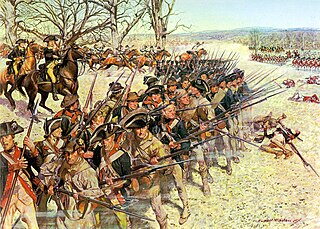
The Battle of Guilford Court House was on March 15, 1781, during the American Revolutionary War, at a site that is now in Greensboro, the seat of Guilford County, North Carolina. A 2,100-man British force under the command of Lieutenant General Charles Cornwallis defeated Major General Nathanael Greene's 4,500 Americans. The British Army suffered considerable casualties, with estimates as high as 27% of their total force.

The Battle of Camden, also known as the Battle of Camden Court House, was a major victory for the British in the Southern theater of the American Revolutionary War. On August 16, 1780, British forces under Lieutenant General Charles, Lord Cornwallis routed the numerically superior American forces led by Major General Horatio Gates about four miles north of Camden, South Carolina, thus strengthening the British hold on the Carolinas following the capture of Charleston.
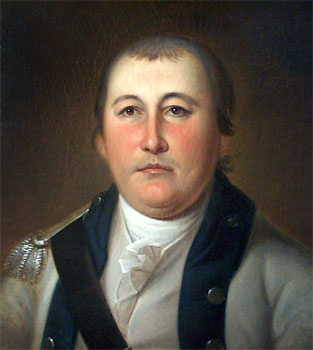
William Washington was a cavalry officer of the Virginia militia and Continental Army during the American Revolutionary War, who also served on General George Washington's staff during the naval war with France in 1798 and held a final rank of brigadier general. Primarily known as a commander of light dragoons, he led mounted troops in a number of notable battles in the Carolinas during the campaigns of 1780 and 1781. Following the conflict, this William Washington moved to South Carolina, where he married and served in the state legislature as well as led the Seventh Brigade of the South Carolina militia. Cavalry Commander William Washington of Stafford County and South Carolina has often been confused with his distant cousin William Augustine Washington, also a Revolutionary War patriot and planter, who served as a delegate representing Westmoreland County, Virginia.

General Sir Banastre Tarleton, 1st Baronet was a British military officer and politician. He is best known as the lieutenant colonel leading the British Legion at the end of the American Revolutionary War. He later served in Portugal and held commands in Ireland and England.

The British Legion was an elite British provincial regiment established during the American Revolutionary War, composed of Loyalist American troops, organized as infantry and cavalry, plus a detachment from the 16th Light Dragoons. The unit was commonly known as Tarleton's Legion, after the British officer who led it on campaign, Lieutenant Colonel Banastre Tarleton. It was a unit the size of a regiment, consisting of artillery, cavalry, and light infantry, and able to operate independently.

Francisco's Fight is the name commonly given to an alleged skirmish between a detachment of the British Legion and Peter Francisco, a Continental Army soldier with a long service record, during the American Revolutionary War in July 1781. Francisco's varying descriptions of the skirmish claimed the death of at least one man and the wounding of several others. It wasn't recorded by anyone else. Later historical accounts of the skirmish embellished the story with details not present in the documentary record.
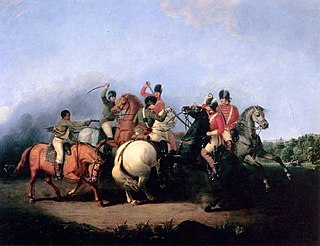
The Battle of Cowpens was a military engagement during the American Revolutionary War fought on January 17, 1781, near the town of Cowpens, South Carolina. American Patriot forces, estimated at 2,000 militia and regulars under Brigadier General Daniel Morgan faced 1,000 British troops under Lieutenant Colonel Banastre Tarleton.
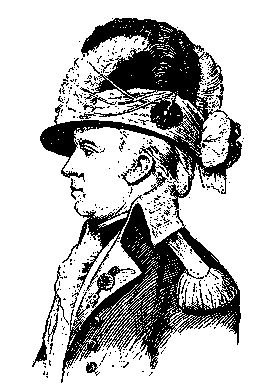
Anthony Walton White was a brigadier general in the Continental Army during the American Revolutionary War who had previously served as an aide-de-camp to General George Washington.

The Battle of Waxhaws was a military engagement which took place on May 29, 1780 during the American Revolutionary War between a Patriot force led by Abraham Buford and a British force led by Lieutenant Colonel Banastre Tarleton near Lancaster, South Carolina. Buford's men consisted of Continental Army soldiers, while Tarleton's force was mostly made up of Loyalist troops. After the two forces sighted each other, Buford rejected an offer of surrender terms and Tarleton's cavalry charged. An unknown number of Buford's men then attempted to surrender at the same time as Tarleton's horse was shot, pinning him underneath. An unknown number of Loyalists, angered by this apparent perfidy, continued their attack, killing several Patriots until order was restored.
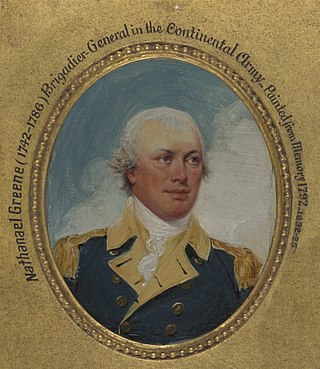
The Battle of Hobkirk's Hill was a battle of the American Revolutionary War fought on April 25, 1781, near Camden, South Carolina. A small American force under Nathanael Greene occupying Hobkirk's Hill, north of Camden, was attacked by British troops led by Francis Rawdon. After a fierce clash, Greene retreated, leaving Rawdon's smaller force in possession of the hill.
The 3rd Continental Light Dragoons (CLD), also known as Baylor's Horse or Lady Washington's Horse, was a mounted regiment of the Continental Army raised on January 1, 1777, at Morristown, New Jersey. The regiment saw action at the Battle of Brandywine, Battle of Germantown and the Battle of Guilford Court House.
Pyle's Massacre was fought during the American Revolutionary War in present-day Alamance County, North Carolina on February 24, 1781. The battle was between Patriot troops attached to the Continental Army under Colonel Henry Lee III and Loyalist North Carolina militiamen commanded by John Pyle. Due to the unique uniform of his forces, the Loyalists mistakenly thought Lee's men were the British Legion, who were en route to reinforce Pyle. When Lee's men opened fire, they took Pyle's force totally by surprise. This resulted in an extremely lopsided victory for Lee, and Pyle's command was scattered and routed.

The southern theater of the American Revolutionary War was the central theater of military operations in the second half of the American Revolutionary War, 1778–1781. It encompassed engagements primarily in Virginia, Georgia, North Carolina, and South Carolina. Tactics consisted of both strategic battles and guerrilla warfare.
The Battle of Lenud's Ferry was a battle of the American Revolutionary War that was fought on May 6, 1780 in present-day Berkeley County, South Carolina. All of the British soldiers who took part in the Battle of Lenud's Ferry were in fact Loyalists who had been born and raised in the colony of South Carolina, with the sole exception being their commanding officer Banastre Tarleton. The unit was known as the Loyalist British Legion, under the command of Lieutenant Colonel Banastre Tarleton. The Loyalist British Legion scattered a company of Patriot militia at Lenud's Ferry, a crossing point on the Santee River, north of which lies present-day Georgetown County.

The Battle of Blackstock's Farm, a military engagement of the American Revolutionary War, took place in what today is Union County, South Carolina, a few miles from Cross Anchor, on November 20, 1780.
The Battle of Wetzell's Mill was an American Revolutionary War battle fought on March 6, 1781, between detachments of Nathanael Greene's Continental Army and militia and Banastre Tarleton's Loyalist provincial troops in Guilford County, North Carolina.
The Battle of Fishdam Ford was an attempted surprise attack by British forces under the command of Major James Wemyss against an encampment of Patriot militia under the command of local Brigadier General Thomas Sumter around 1 am on the morning of November 9, 1780, late in the American Revolutionary War. Wemyss was wounded and captured in the attack, which failed because of heightened security in Sumter's camp and because Wemyss did not wait until dawn to begin the attack.

The Battle of Torrence's Tavern was a minor engagement of the American Revolutionary War that took place in what was the western portion of Rowan County, North Carolina, approximately 10 miles (16 km) east of the Catawba River near modern-day Mooresville in Iredell County. Torrence's Tavern was a part of the larger Southern campaign of the American Revolution, which, by 1780–1781 involved a series of clashes between the British Army and Loyalist militia and the Continental Army and Patriot militia in the Piedmont region of North and South Carolina.












